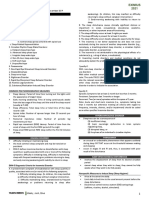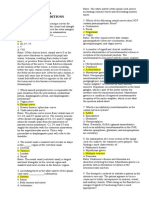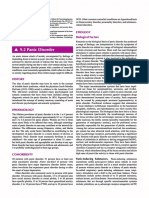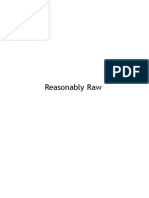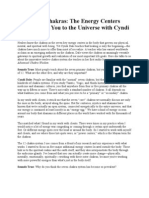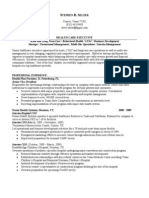Postreading Self-Assessment and CME Test
Postreading Self-Assessment and CME Test
Uploaded by
dr.cidgutCopyright:
Available Formats
Postreading Self-Assessment and CME Test
Postreading Self-Assessment and CME Test
Uploaded by
dr.cidgutCopyright
Available Formats
Share this document
Did you find this document useful?
Is this content inappropriate?
Copyright:
Available Formats
Postreading Self-Assessment and CME Test
Postreading Self-Assessment and CME Test
Uploaded by
dr.cidgutCopyright:
Available Formats
Postreading
SELF-ASSESSMENT
AND CME
Self-Assessment
and CME Test
By D. Joanne Lynn, MD, FAAN; James W. M. Owens Jr, MD, PhD
SLEEP NEUROLOGY
The Continuum Postreading Self-Assessment and CME Test is an integral
part of the issue that is intended to stimulate thought and help participants
assess general understanding of the material presented in this issue. The
Postreading Self-Assessment and CME Test is also approved by the
American Board of Psychiatry and Neurology (ABPN) to meet the Lifelong
Learning (CME), Self-Assessment (SA) (part 2) component for Continuing
Certification (CC).
For each item, select the single best response. A tally sheet is provided
with this issue to allow the option of marking answers before entering them
online at continpub.com/CME. Nonsubscribers who have purchased single
back issues should email ContinuumCME@aan.com for instructions to
complete this test online.
US PARTICIPANTS: Upon the completion of the Postreading Self-Assessment
and CME Test and issue evaluation online at continpub.com/CME,
participants may earn up to 20 AMA PRA Category 1 CreditsTM toward
SA-CME. US participants have up to 3 years from the date of publication
online to earn SA-CME credits.
CANADIAN PARTICIPANTS: This program is an Accredited Self-Assessment
Program (Section 3) as defined by the Maintenance of Certification
Program of the Royal College of Physicians and Surgeons of Canada and
approved by the University of Calgary Office of Continuing Medical
Education and Professional Development. Canadian participants should
visit MAINPORT (mainport.org) to record learning and outcomes. Canadian
participants can claim a maximum of 20 hours per issue (credits are
automatically calculated).
CONTINUUMJOURNAL.COM 1085
Copyright © American Academy of Neurology. Unauthorized reproduction of this article is prohibited.
POSTREADING TEST
ARTICLE 1: NEUROBIOLOGY AND NEUROPROTECTIVE BENEFITS OF SLEEP
1 Which of the following types of neurons demonstrates the highest
activity during wakefulness and rapid eye movement (REM) sleep?
A cholinergic
B dopaminergic
C glutamatergic
D histaminergic
E serotonergic
2 The potent wake-promoting effect of orexin (hypocretin)–producing
neurons is likely due to innervation of which of the following nuclei?
A dorsal raphe
B lateral dorsal tegmental
C locus coeruleus
D parabrachial
E pedunculopontine
3 The most prominent impairments of consciousness are seen with
lesions of which of the following regions or nuclei?
A dorsal raphe nuclei
B lateral dorsal tegmental
C parabrachial
D tuberomammillary
E ventral lateral pre-optic
4 An increase in which of the following substances is implicated in the
homeostatic sleep drive?
A adenosine
B cortisol
C dopamine
D hypocretin
E melatonin
1086 AUGUST 2020
Copyright © American Academy of Neurology. Unauthorized reproduction of this article is prohibited.
ARTICLE 2: EVALUATING THE SLEEPY AND SLEEPLESS PATIENT
5 Which of the following findings on physical examination is correlated
with an increased risk of obstructive sleep apnea?
A history of adenotonsillectomy
B macroglossia
C neck circumference of 38 cm (15 in) in a man
D orthostatic hypotension
E prognathia
6 A 24-year-old man has had problems with excessive daytime
sleepiness for the past 3 months. He reports 8 hours of sleep each night
but still finds himself falling asleep in class, during quiet times, and
even while driving. He has experienced sleep paralysis and cataplexy
several times in the past few months. Which of the following
diagnostic tests will be most helpful?
A brain MRI
B EEG
C home sleep apnea test
D maintenance of wakefulness test
E multiple sleep latency test
7 A home sleep apnea test is indicated for evaluation of patients at
increased risk of which of these diagnostic possibilities?
A central sleep apnea
B moderate obstructive sleep apnea
C narcolepsy
D nocturnal hypoxemia
E sleep-related movement disorders
8 Morning headaches are a common symptom of which of the following
sleep disorders?
A circadian rhythm disorders
B narcolepsy
C obstructive sleep apnea
D periodic limb movement disorder
E restless legs syndrome
CONTINUUMJOURNAL.COM 1087
Copyright © American Academy of Neurology. Unauthorized reproduction of this article is prohibited.
POSTREADING TEST
ARTICLE 3: CENTRAL DISORDERS OF HYPERSOMNOLENCE
9 Which of the following clinical features distinguishes between
narcolepsy type 1 and type 2?
A cataplexy
B daytime sleep attacks
C disrupted nocturnal sleep
D sleep paralysis
E sleep-related hallucinations
10 A 32-year-old man has a long history of excessive sleepiness. For the
past 12 years, he has slept 11 to 12 hours every night yet remained
sleepy during the day, usually resulting in at least one nap lasting
more than an hour. He does not feel refreshed when awakening in the
morning or from one of his daytime naps. On the contrary, he
typically feels very groggy and cognitively “foggy” upon awakening.
He does not report a history of unexplained falls. He has
hypertension, adult-onset diabetes, and hypercholesterolemia, all
under good control with medications. His neurologic examination is
normal except for his very sleepy appearance. Which of the following
conditions is most likely in this patient?
A hypersomnia due to a medical disorder
B idiopathic hypersomnia
C insufficient sleep syndrome
D Kleine-Levin syndrome
E narcolepsy type 1
11 A 16-year-old boy has had several episodes of hypersomnolence
lasting for 2 to 3 weeks followed by a return to his
neurodevelopmentally normal baseline. During these episodes, he
sleeps for 16 to 18 hours per day with periods of wakefulness
characterized by apathy and hyperphagia. He has no other medical
problems, and between these episodes, his neurologic examination is
entirely normal. Which of the following medications could help to
decrease the frequency of these attacks of hypersomnolence?
A lithium
B methylphenidate
C pitolisant
D sodium oxybate
E solriamfetol
1088 AUGUST 2020
Copyright © American Academy of Neurology. Unauthorized reproduction of this article is prohibited.
12 Scheduled naps and regular nocturnal sleep scheduling can provide
significant benefit in which of the following disorders?
A chronic insomnia
B idiopathic hypersomnia
C insufficient sleep syndrome
D Kleine-Levin syndrome
E narcolepsy type 1
ARTICLE 4: OBSTRUCTIVE SLEEP APNEA
13 Women with obstructive sleep apnea are more likely to present with
which of the following symptoms compared with men with a similar
severity of disease?
A apneas
B delirium
C gasping
D insomnia
E snoring
14 The presence of which of the following characteristics on visual
inspection of the tongue might suggest an increased risk for
obstructive sleep apnea?
A fissuring
B geographic tongue
C leukoplakia
D lichen planus
E scalloping
15 The respiratory disturbance index is a measure of obstructive sleep
apnea severity that differs from the apnea-hypopnea index in that it
includes which of the following in addition to apneas and hypopneas?
A changes in sleeping position
B episodes of oxygen desaturation
C periodic leg movements
D respiratory arousals on EEG
E runs of ventricular ectopy
CONTINUUMJOURNAL.COM 1089
Copyright © American Academy of Neurology. Unauthorized reproduction of this article is prohibited.
POSTREADING TEST
16 Which of the following is the most common surgical intervention for
the treatment of obstructive sleep apnea in adults?
A adenotonsillectomy
B implantation of a phrenic nerve stimulator
C implantation of an upper airway stimulator
D mandibular advancement
E uvulopalatopharyngoplasty
ARTICLE 5: RAPID EYE MOVEMENT SLEEP BEHAVIOR DISORDER AND
OTHER RAPID EYE MOVEMENT PARASOMNIAS
17 People with rapid eye movement (REM) sleep behavior disorder are
at the highest risk of developing which of the following
neurodegenerative diseases?
A Alzheimer disease
B amyotrophic lateral sclerosis
C corticobasal degeneration
D dementia with Lewy bodies
E Huntington disease
18 Which of the following is postulated to be one of the functions of
rapid eye movement (REM) sleep?
A clearance of metabolic wastes
B conservation of energy
C consolidation of emotionally laden memories
D motor skill learning
E pruning of synapses
19 Which of the following is first-line pharmacotherapy to decrease
rapid eye movement (REM) motor activity in patients with REM sleep
behavior disorder?
A alprazolam
B baclofen
C donepezil
D gabapentin
E melatonin
1090 AUGUST 2020
Copyright © American Academy of Neurology. Unauthorized reproduction of this article is prohibited.
20 The presence of rapid eye movement (REM) sleep behavior disorder in
a patient with Parkinson disease is associated with which of the
following?
A absence of hallucinations
B fewer motor fluctuations
C indolent less aggressive course
D less autonomic instability
E non–tremor-predominant presentation
ARTICLE 6: PARASOMNIAS OCCURRING IN NON–RAPID EYE MOVEMENT
SLEEP
21 A 27-year-old woman comes to clinic with a several-year history of
nocturnal episodes. The events are characterized by sitting up in bed
with feelings of shortness of breath, palpitations, paresthesia of her
fingers bilaterally, and a feeling of dread. The events tend to occur in
the first half of the nocturnal sleep period. She does not recall any
associated dream imagery preceding the event but fully recalls the
experience of the event itself. When asked by her bed partner what is
happening, she is able to say that she is having a “spell” and describe
what she is feeling. After the event, she is eventually able to return to
sleep. She has a history of a generalized anxiety disorder, for which she
is pursuing cognitive-behavioral therapy. Her neurologic examination
is entirely normal. Which of the following disorders is most likely
responsible for her events?
A confusional arousals
B nightmares
C nocturnal panic attacks
D rapid eye movement (REM) sleep behavior disorder
E sleep terrors
22 For a patient with a history of potentially injurious behaviors during
sleepwalking episodes, which of the following medications would be
most appropriate?
A clonazepam
B haloperidol
C sodium oxybate
D trazodone
E zolpidem
CONTINUUMJOURNAL.COM 1091
Copyright © American Academy of Neurology. Unauthorized reproduction of this article is prohibited.
POSTREADING TEST
23 A 6-year-old boy has nightly episodes that are stereotyped and brief,
usually lasting less than 60 seconds. His parents first noted something
was amiss when he began to wet the bed again after a year of being dry
at night. The parents moved him to their bed so they could monitor the
episodes. The episodes occur at any time of night and begin with a
moan and brief stiffening followed by shaking of his limbs, during
which enuresis occurs. This is followed by a brief arousal and return to
sleep. The patient does not recall anything specific about the nocturnal
events but does remember that “he had one.” Given this description,
which of the following types of nocturnal events is most likely?
A confusional arousal
B rapid eye movement (REM) sleep behavior disorder
C rhythmic movement disorder
D seizure
E sleep terror
ARTICLE 7: RESTLESS LEGS SYNDROME AND OTHER COMMON
SLEEP-RELATED MOVEMENT DISORDERS
24 A 45-year-old man with restless legs syndrome has continued to have
bothersome symptoms despite adequate trials of increased exercise
and improved sleep hygiene. He has also tried iron therapy resulting in
a serum ferritin level of 500 ng/mL and transferrin saturation of 60%.
He has gastroesophageal reflux disease, for which he takes ranitidine
and metoclopramide, as well as hypertension that is well controlled
with lisinopril. He has a long-standing history of initiation insomnia
treated with a combination of melatonin and zolpidem. Which of the
following interventions would be best to try next?
A begin clonazepam
B begin pramipexole
C stop metoclopramide
D stop zolpidem
E switch lisinopril for another antihypertensive
1092 AUGUST 2020
Copyright © American Academy of Neurology. Unauthorized reproduction of this article is prohibited.
25 A 57-year-old patient comes to sleep clinic with restless legs
syndrome symptoms that have been gradually worsening despite
nonpharmacologic interventions. A sleep study reveals that the patient
also has frequent periodic limb movements that are not associated
with arousals. He has hypertension, which was well controlled but is
now more variable and less responsive to medication. His serum
ferritin level is 80 ng/mL with a transferrin saturation of 28%. Which
of the following therapeutic interventions would be best to try next?
A clonazepam
B gabapentin
C IV iron
D oral iron supplementation
E pramipexole
26 A 52-year-old returns to sleep clinic after an overnight sleep study. He
had initially come to clinic with excessive daytime somnolence that
proved unresponsive to improved sleep hygiene measures. He was
diagnosed with restless legs syndrome several years ago, and his
daytime symptoms are well managed with gabapentin, but he feels
that he is a “restless sleeper.” His sleep study revealed an
apnea-hypopnea index of 15 events per hour and a periodic limb
movement index of 5. Which of the following disorders is most likely
responsible for this patient’s excessive daytime somnolence?
A obstructive sleep apnea
B periodic limb movement disorder
C propriospinal myoclonus
D rapid eye movement (REM) sleep behavior disorder
E sleep-related rhythmic movement disorder
27 An 18-month-old boy is brought to clinic for head banging at night. His
parents report that, soon after falling asleep, he will get on all four
limbs and then rock back and forth with his head repetitively hitting
the headboard of his crib. He has awoken with forehead bruising, and
his parents feel that he is more irritable during the day since these
behaviors have begun. Once he falls asleep, he generally sleeps well,
and there are no other nocturnal episodes of concern. He is otherwise
neurodevelopmentally normal with a normal neurologic examination.
Which of the following treatments would be most appropriate in
this case?
A clonazepam
B gabapentin
C iron
D levodopa
E pramipexole
CONTINUUMJOURNAL.COM 1093
Copyright © American Academy of Neurology. Unauthorized reproduction of this article is prohibited.
POSTREADING TEST
ARTICLE 8: CIRCADIAN RHYTHM SLEEP-WAKE DISORDERS
28 A 67-year-old man with progressive retinal degeneration has
developed more difficulties with sleep. Initially, he experienced
trouble falling asleep at night and difficulties awakening as early as he
wished in the morning. More recently, his sleep has grown more
disturbed and appears to follow a non–24-hour pattern. What
medication is US Food and Drug Administration (FDA) approved for
this disorder?
A caffeine
B lemborexant
C melatonin
D modafinil
E tasimelteon
29 Which of these sleep disorders has been associated with an increased
risk of breast cancer?
A delayed sleep-wake phase disorder
B insomnia
C jet lag disorder
D non–24-hour sleep-wake rhythm disorder
E shift work disorder
30 In mammals, circadian rhythms are coordinated by which
hypothalamic nucleus structure?
A arcuate
B dorsomedial
C preoptic
D suprachiasmatic
E tuberomammillary
ARTICLE 9: INSOMNIA
31 Which of the following interventions is considered first-line therapy
for adult patients with insomnia?
A bioenergy therapy
B cognitive-behavioral therapy
C energetic sleep hygiene
D melatonin
E zolpidem
1094 AUGUST 2020
Copyright © American Academy of Neurology. Unauthorized reproduction of this article is prohibited.
32 Which of the following integrative medicine treatments for insomnia
is associated with potential side effects such as headache, drowsiness,
false memories, and strong emotions?
A acupuncture
B autonomous meridian sensory response
C hypnotherapy
D Reiki
E therapeutic touch
33 Which of the following sleep aid strategies aims at producing a
tinglinglike sensation across the scalp and back of the neck in response
to specific auditory and visual stimuli?
A autonomous sensory meridian response
B healing touch
C Qigong
D Reiki
E tactile therapy
ARTICLE 10: SLEEP IN PATIENTS WITH NEUROLOGIC DISEASE
34 The irregular sleep-wake rhythm and phenomenon of “sundowning”
that occur in Alzheimer disease correlate to a critical loss of neuronal
populations in what brain area?
A lateral hypothalamus
B midbrain reticular formation
C nucleus accumbens
D suprachiasmatic nuclei
E ventral medial hypothalamus
35 Patients with idiopathic rapid eye movement (REM) sleep behavior
disorder have a high incidence of conversion to Parkinson disease. The
risk is further increased by the presence of which of these factors?
A history of smoking
B hypertension
C hyposmia
D negative family history for movement disorders
E younger age
CONTINUUMJOURNAL.COM 1095
Copyright © American Academy of Neurology. Unauthorized reproduction of this article is prohibited.
POSTREADING TEST
36 Which of the following movement disorders is recognized as one for
which abnormal movements typically persist during sleep?
A dystonia
B essential tremor
C Huntington disease
D Parkinson disease
E tardive dyskinesia
ARTICLE 11: SLEEP-WAKE DISORDERS IN CHILDHOOD
37 A child with significant insomnia, which has proved incompletely
responsive to behavioral intervention, is placed on a low starting dose
of a hypnotic medication. After the low-dose hypnotic is initiated, he
seems agitated at bedtime and his insomnia worsens. How should this
response to medication be classified?
A adverse effect
B allergy
C behavioral disorder
D paradoxical reaction
E pharmacogenomic trait
38 A 5-year-old girl is seen in a sleep clinic because of excessive daytime
somnolence. She gets 10 to 10.5 hours of sleep per 24 hours and does not
have difficulty falling asleep. She has confusional arousals every few
weeks, but these seem to be less frequent now. She is described as “a
very active sleeper,” frequently winding up with her head at the foot
of the bed. She finds it difficult to awaken in the morning. There are no
reports of morning headaches, and she does not snore. Her birth
history and past medical history are unremarkable, and her
developmental history is on track with no change in trajectory. Her
general physical and neurologic examinations are normal. She
undergoes overnight polysomnography, which reveals an
apnea-hypopnea index of 0.5 and a periodic limb movement index of
3 events per hour. Which of the following sleep disorders most likely
explains her daytime somnolence?
A chronic insomnia
B idiopathic hypersomnia
C insufficient sleep syndrome
D restless legs syndrome
E restless sleep disorder
1096 AUGUST 2020
Copyright © American Academy of Neurology. Unauthorized reproduction of this article is prohibited.
39 For a patient with frequent parasomnias who does not have evidence
of obstructive sleep apnea or periodic limb movement disorder on
overnight polysomnography and who receives an appropriate total
duration of sleep for his or her age, which of the following medications
should be considered?
A baclofen
B clonazepam
C fluoxetine
D gabapentin
E sodium oxybate
40 For patients with Smith-Magenis syndrome, in addition to melatonin
at bedtime, which of the following interventions is recommended?
A beta-blocker in the morning
B clonidine at night
C iron supplementation
D melatonin in the morning
E trazodone at night
CONTINUUMJOURNAL.COM 1097
Copyright © American Academy of Neurology. Unauthorized reproduction of this article is prohibited.
You might also like
- Mock5 PDFDocument19 pagesMock5 PDFSpacetoon Days100% (1)
- ADHD OaplDocument145 pagesADHD Oaplminiloup05No ratings yet
- Postreading Self-Assessment and CME Test: Sleep NeurologyDocument11 pagesPostreading Self-Assessment and CME Test: Sleep NeurologyJafild Fild riverNo ratings yet
- Multiple-Choice Questions: I Toward Self-Assessment CME. Category 1 CME Credits Not DesigDocument9 pagesMultiple-Choice Questions: I Toward Self-Assessment CME. Category 1 CME Credits Not DesigManish MauryaNo ratings yet
- Multiple-Choice Questions: I Toward Self-Assessment CME. Category 1 CME CreditsDocument9 pagesMultiple-Choice Questions: I Toward Self-Assessment CME. Category 1 CME CreditsWasuchon ChaichanNo ratings yet
- Narcolepsy and CataplexyDocument6 pagesNarcolepsy and CataplexyAh BoonNo ratings yet
- Sleep Disorder: Pembicara:Dr. Ratri Wulandari Pembimbing: DR Sri Handayani, SpsDocument57 pagesSleep Disorder: Pembicara:Dr. Ratri Wulandari Pembimbing: DR Sri Handayani, SpsRatri Wulandari SusilaningrumNo ratings yet
- Postreading Self-Assessment and CME Test-Preferred ResponsesDocument10 pagesPostreading Self-Assessment and CME Test-Preferred Responsesdr.cidgutNo ratings yet
- Abpsych - Sleep Wake Disorders RevDocument2 pagesAbpsych - Sleep Wake Disorders Revaquinogerald828No ratings yet
- Neurobiology Final AnswersDocument9 pagesNeurobiology Final Answersjim jamesNo ratings yet
- For confusional migraneDocument4 pagesFor confusional migranedevendra khandkeNo ratings yet
- KATELYN DECKER - States of Consciousness Review Sheet #5Document5 pagesKATELYN DECKER - States of Consciousness Review Sheet #5katelyn roseNo ratings yet
- Pediatric Epilepsies: This Is Only For UAMS Neurology Internal UseDocument57 pagesPediatric Epilepsies: This Is Only For UAMS Neurology Internal UsePlay100% (1)
- NSG 591 - Week 9 Review QuestionsDocument13 pagesNSG 591 - Week 9 Review QuestionsmarvluvmichnmjsNo ratings yet
- Part 2 NeurodegenDocument9 pagesPart 2 NeurodegenMicole NatividadNo ratings yet
- Mrcpsych Paper A2 Mock Examination 1 Questions Practice BookDocument328 pagesMrcpsych Paper A2 Mock Examination 1 Questions Practice BookVinotheny SegarmurthyNo ratings yet
- Seleksi Imo SoalDocument11 pagesSeleksi Imo SoalOlga FannyNo ratings yet
- Sleep Wake DisordersDocument5 pagesSleep Wake DisordersIsabel CastilloNo ratings yet
- USMLE Case - CompressedDocument57 pagesUSMLE Case - CompressedTzu-Fan WengNo ratings yet
- Midterm1 2024 MAIN FormCDocument7 pagesMidterm1 2024 MAIN FormCPortia AwuahNo ratings yet
- Mahoney 2018Document11 pagesMahoney 2018Aldo GuascoNo ratings yet
- Insomnia Pada LansiaDocument8 pagesInsomnia Pada LansiaCendani Ratih WulandariNo ratings yet
- Path o Physiology ConciousnessDocument4 pagesPath o Physiology ConciousnessaristadevyaNo ratings yet
- By: Reashnaa A/P Loganathan Yunisa Meutia Putri Zahra Fitrianti Preseptor: R.M. Haryadi Karyono, DR., SPKJDocument51 pagesBy: Reashnaa A/P Loganathan Yunisa Meutia Putri Zahra Fitrianti Preseptor: R.M. Haryadi Karyono, DR., SPKJmeutiaputripuyNo ratings yet
- Soal + Pembahasan - Epilepsy and Seizure - 2Document2 pagesSoal + Pembahasan - Epilepsy and Seizure - 2jumasriNo ratings yet
- (PSYCH) Neurocognitive DisordersDocument14 pages(PSYCH) Neurocognitive DisordersThesa TagalogNo ratings yet
- Disorders of Consciousness (2017)Document14 pagesDisorders of Consciousness (2017)lfdealmeiNo ratings yet
- SPS 143 Psychology 3 (Question and Answer)Document10 pagesSPS 143 Psychology 3 (Question and Answer)Qistina ShahrilNo ratings yet
- Outline: Varieties of ConsciousnessDocument22 pagesOutline: Varieties of ConsciousnessElber Andrew100% (1)
- Hypersomnia: PMC Labs Learn MoreDocument11 pagesHypersomnia: PMC Labs Learn MoremusdalifahNo ratings yet
- QuestionsDocument8 pagesQuestionsAndrei BulgariuNo ratings yet
- PSYC 301 Exam 4 Study GuideDocument22 pagesPSYC 301 Exam 4 Study Guidefglo188No ratings yet
- Neuroanatomy & Neurologic Conditions QuestionsDocument6 pagesNeuroanatomy & Neurologic Conditions QuestionsPaula ColeenNo ratings yet
- Postreading Self Assessment and CME Test Preferred.28Document22 pagesPostreading Self Assessment and CME Test Preferred.28مجاهد إسماعيل حسن حسينNo ratings yet
- Sleep Paralysis: June 2012Document8 pagesSleep Paralysis: June 2012edamwone04No ratings yet
- Alvászavar És MigrénDocument10 pagesAlvászavar És MigrénLindenberger BoriszNo ratings yet
- Sleep and Disorders of Sleep: Neuroanatomy and Neurophysiology WakefulnessDocument11 pagesSleep and Disorders of Sleep: Neuroanatomy and Neurophysiology WakefulnessTeslim RajiNo ratings yet
- Midterm1 2024 MAIN FormBDocument7 pagesMidterm1 2024 MAIN FormBPortia AwuahNo ratings yet
- Immune, Inflammatory and Cardiovascular Consequences of Sleep Restrictionand RecoveryDocument13 pagesImmune, Inflammatory and Cardiovascular Consequences of Sleep Restrictionand RecoveryUlysses GabrielNo ratings yet
- Week 6 (Chapter 5) Lecture Slides (4)Document62 pagesWeek 6 (Chapter 5) Lecture Slides (4)TradconNo ratings yet
- 11 InsomniaDocument8 pages11 InsomniaDr Jyoti Prakash C K AcharyaNo ratings yet
- Cefalea de Caracteristicas Migrañosas Por Cefalea Post Ictal y MeningioangiomatosisDocument5 pagesCefalea de Caracteristicas Migrañosas Por Cefalea Post Ictal y MeningioangiomatosisFarid Santiago Abedrabbo LombeydaNo ratings yet
- Pato Insomnia PDFDocument14 pagesPato Insomnia PDFdilaNo ratings yet
- 2016 Brain Bee Competitions Questions - DoDocument10 pages2016 Brain Bee Competitions Questions - DoughNo ratings yet
- Psychogenic Non-Epileptic Seizures: Indian Pediatrics November 2004Document4 pagesPsychogenic Non-Epileptic Seizures: Indian Pediatrics November 2004Nico NicoNo ratings yet
- DIPIRO SLEEP DISORDERSDocument11 pagesDIPIRO SLEEP DISORDERSAinun MufidahNo ratings yet
- 9.2 Panic Disorder: Etiology Biological FactorsDocument7 pages9.2 Panic Disorder: Etiology Biological FactorsFayeNo ratings yet
- Cooling TherapyDocument44 pagesCooling TherapyNICU LEVELNo ratings yet
- Consciousness, The Brain, and Behavior: Multiple Choice QuestionsDocument31 pagesConsciousness, The Brain, and Behavior: Multiple Choice QuestionswanderagroNo ratings yet
- 292-Article Text-486-1-10-20220406Document7 pages292-Article Text-486-1-10-20220406sinha aNo ratings yet
- أسئلة باوربوينتDocument68 pagesأسئلة باوربوينتomar beltagyNo ratings yet
- NarcolepsyDocument9 pagesNarcolepsyalejabordaNo ratings yet
- Psychology Core Final 240519 144947Document10 pagesPsychology Core Final 240519 144947Farah IbraheemNo ratings yet
- Chapter IDocument8 pagesChapter IRahmakumalasariNo ratings yet
- Consciousness: Claudine Anderson-Atkinson, PH.DDocument69 pagesConsciousness: Claudine Anderson-Atkinson, PH.DOdaine BennettNo ratings yet
- ICSD 3 TR Parasomnias DraftDocument62 pagesICSD 3 TR Parasomnias Draftسعيد المفرجيNo ratings yet
- Copy of Consciousness 2020-1.docxDocument4 pagesCopy of Consciousness 2020-1.docxcarla villarroelNo ratings yet
- Sleep Architectural Dysfunction and Undiagnosed Obstructive SleepDocument9 pagesSleep Architectural Dysfunction and Undiagnosed Obstructive Sleepluigi.pietro.carlo.undaNo ratings yet
- Comatose Patient IIIDocument5 pagesComatose Patient IIIUWIMANA Jean ClaudeNo ratings yet
- Comprehensive PsychiatryDocument7 pagesComprehensive PsychiatryOrangee JuceeyNo ratings yet
- Narcolepsy (Updated), A Simple Guide To The Condition, Diagnosis, Treatment And Related ConditionsFrom EverandNarcolepsy (Updated), A Simple Guide To The Condition, Diagnosis, Treatment And Related ConditionsNo ratings yet
- List of Fast Moving Medicines: S.No Generic Name Drugs/Item NameDocument2 pagesList of Fast Moving Medicines: S.No Generic Name Drugs/Item NameImran KhanNo ratings yet
- Bhringraj Oil and Hair GrowthDocument3 pagesBhringraj Oil and Hair GrowthsamreeniqbalNo ratings yet
- 5..Mqst Page 395-419Document25 pages5..Mqst Page 395-419SAEEDAAHMERNo ratings yet
- Edibles List Magazine - Issue 16Document33 pagesEdibles List Magazine - Issue 16Edibles Magazine100% (1)
- Dissertation On Acute Coronary SyndromeDocument4 pagesDissertation On Acute Coronary SyndromeFindSomeoneToWriteMyCollegePaperDesMoines100% (1)
- NURS FPX 6016 Assessment 3 Data Analysis and Quality Improvement Initative ProposalDocument5 pagesNURS FPX 6016 Assessment 3 Data Analysis and Quality Improvement Initative Proposallilykevin075No ratings yet
- Reasonably RawDocument169 pagesReasonably Rawoanas_2003100% (4)
- 5 Outer ChakrasDocument6 pages5 Outer ChakrasClarence100% (3)
- Adjuncts To Mechanical Ventilation: Tantani SugimanDocument36 pagesAdjuncts To Mechanical Ventilation: Tantani SugimanAndi Upik FathurNo ratings yet
- DHA Standards For Day Surgical CentresDocument103 pagesDHA Standards For Day Surgical CentresJanethes SandeNo ratings yet
- Excipient PT FinalDocument14 pagesExcipient PT FinalPreeti Wavikar-Panhale100% (1)
- Homoeopathic PharmacyDocument2 pagesHomoeopathic Pharmacytadvinir1710No ratings yet
- Hospital CEO in Houston TX Resume Stephen SelzerDocument4 pagesHospital CEO in Houston TX Resume Stephen SelzerStephenSelzerNo ratings yet
- Tuberculosis Care Plan SoniDocument23 pagesTuberculosis Care Plan SoniSanvar Mal Soni100% (2)
- Galenical Preparations PDFDocument150 pagesGalenical Preparations PDFMai Elnaggar67% (3)
- Konsep EWS Di RSDocument50 pagesKonsep EWS Di RSkencaNo ratings yet
- Types of SuturesDocument7 pagesTypes of SuturesSaima BataloNo ratings yet
- Threats On Child Health and SurvivalDocument14 pagesThreats On Child Health and SurvivalVikas SamvadNo ratings yet
- Sharpy's Surgical Series PresentationDocument244 pagesSharpy's Surgical Series PresentationhappyhappylandNo ratings yet
- Faust's Anesthesiology Review. 4th Edition. ISBN 1437713696, 978-1437713695Document23 pagesFaust's Anesthesiology Review. 4th Edition. ISBN 1437713696, 978-1437713695ellettecowdenbvb100% (7)
- FILL and UPLOAD Week 4 - Accident Investigation FormDocument5 pagesFILL and UPLOAD Week 4 - Accident Investigation FormAnonymous HizOWFNo ratings yet
- 2019-08-15 Problem Based Learning PSSKPDDocument16 pages2019-08-15 Problem Based Learning PSSKPDAnonymous B5CaVOAtNo ratings yet
- Amanda Byrne Resume 2018 LPN 1Document3 pagesAmanda Byrne Resume 2018 LPN 1api-413167235No ratings yet
- Bobath Case ReportDocument12 pagesBobath Case Reportsridhar100% (1)
- Prime Care Factsheet 260314Document8 pagesPrime Care Factsheet 260314Leonard YangNo ratings yet
- Absorbance at 405Nm: United States PatentDocument20 pagesAbsorbance at 405Nm: United States Patentfelipe_fismed4429No ratings yet
- Granata 2011 EpilepsiaDocument5 pagesGranata 2011 EpilepsiaAlexandra PrikopNo ratings yet
- "The Effectiveness of Rosewater As A Hydrating Facial Mist": Sti College San FernandoDocument34 pages"The Effectiveness of Rosewater As A Hydrating Facial Mist": Sti College San FernandoKay TupazNo ratings yet
- Risks of Self-Medication PracticesDocument28 pagesRisks of Self-Medication PracticesFaizaNadeemNo ratings yet

















